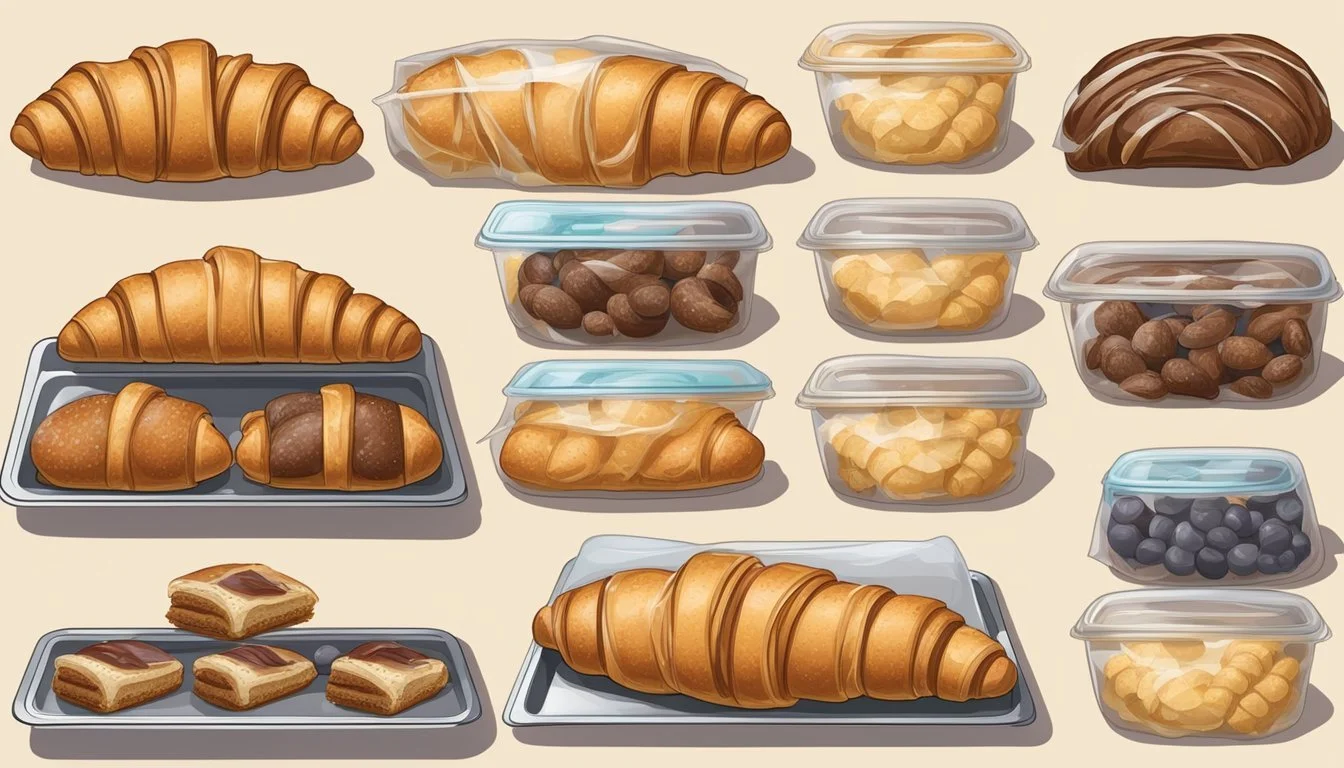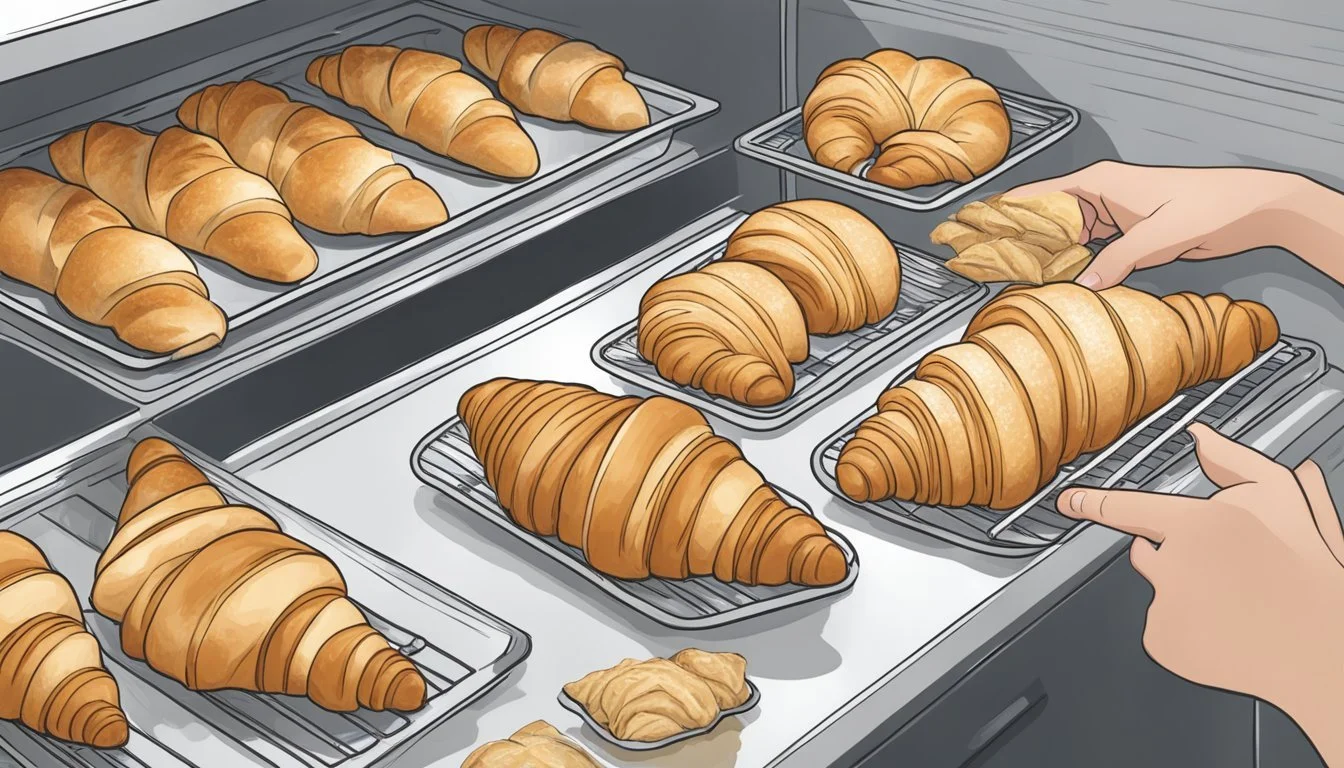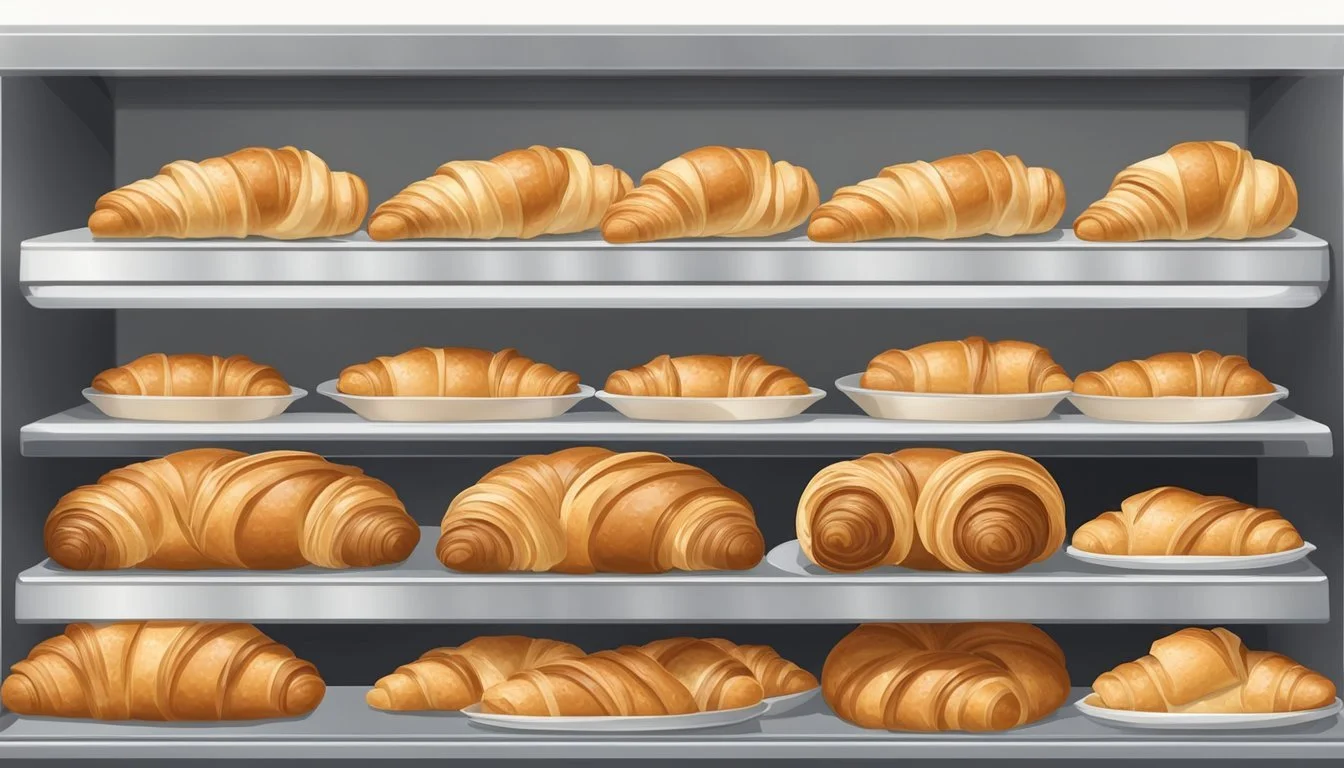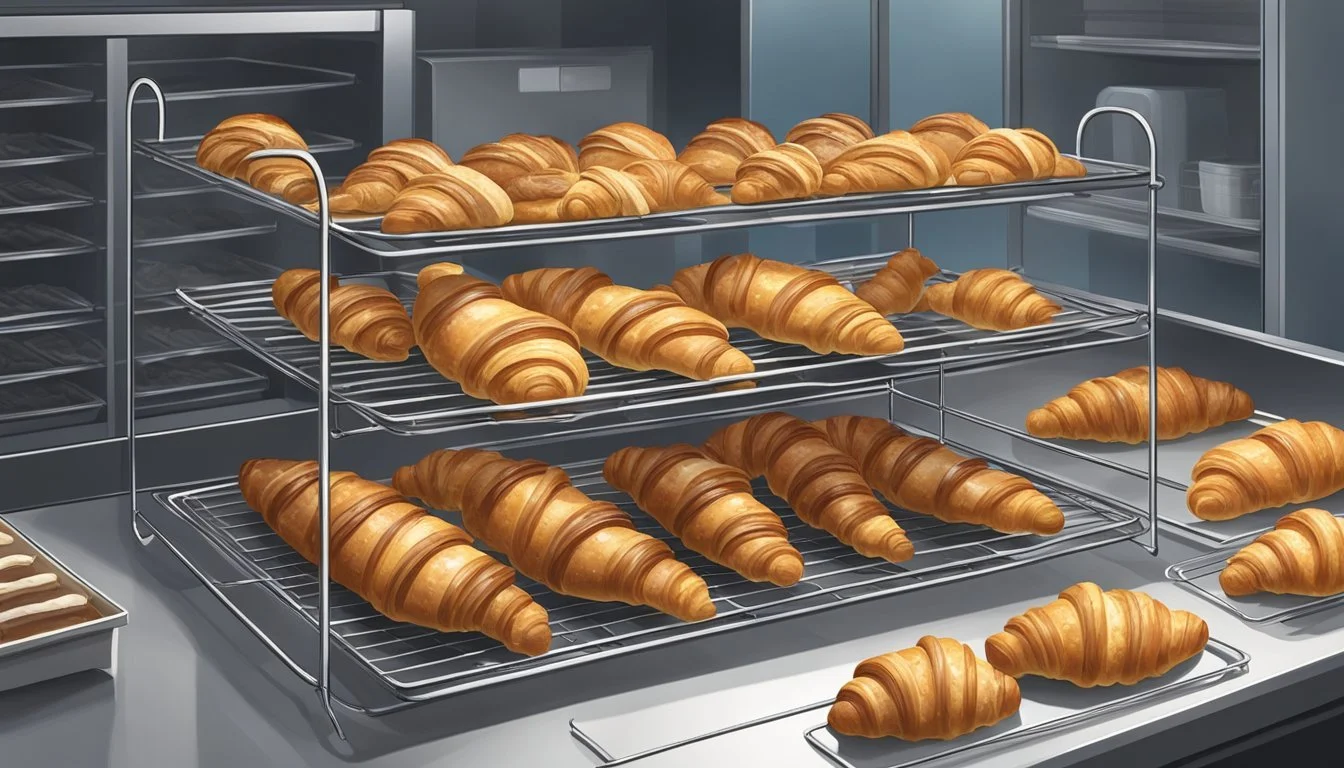How to Freeze Croissants and Pastries Properly
A Step-by-Step Guide
Freezing croissants and pastries is an excellent method to extend their shelf life while maintaining taste and texture. When done correctly, it allows one to enjoy these baked goods at a later date as if they were fresh from the bakery. The key is in the preparation and storage process, which ensures that the croissants and pastries do not lose their quality during freezing.
To ensure pastries remain delicious after freezing, it is important to allow them to cool completely before beginning the freezing process. This prevents condensation from forming, which can lead to sogginess or freezer burn. Once cooled, individual wrapping in plastic, aluminum foil, or parchment paper protects the integrity of the pastry by warding off moisture and preventing the absorption of odors from other foods.
Further, proper labeling and packaging are essential steps to successfully freeze croissants and pastries. Utilizing freezer-safe bags or containers, clearly marking the contents and date of freezing, helps in organizing the freezer and keeping track of the storage duration. With these steps adhered to, pastries can be frozen for several weeks while maintaining their baked-to-perfection quality.
Benefits of Freezing Croissants
Freezing croissants offers several advantages, particularly regarding maintaining freshness and reducing waste. When croissants are frozen, the original texture and flavor can be preserved, ensuring that they taste as close to fresh as possible. The presence of high-fat content, primarily from butter, allows for the retention of the pastry's quality during freezing and thawing.
Convenience is another significant benefit. Bakers and consumers can bake or purchase croissants in bulk, freeze them, and enjoy them at a later date without a hurried trip to the bakery. This flexibility means croissants can be enjoyed on demand, providing versatility in meal planning or unexpected guest hosting.
Here is an overview of the key benefits:
Freshness Preservation: Freezing slows down staling, allowing the croissants to maintain their fresh-baked taste when properly reheated.
Texture Maintenance: Proper freezing techniques help in retaining the delicate, flaky texture of croissants.
Flavor Retention: The flavors stay intact during freezing, so one can still enjoy the rich, buttery taste post-thawing.
Convenience: Having frozen croissants on hand means they can be served with little preparation time needed.
Extended Shelf Life: Freezing croissants can extend their shelf life by weeks or even months, significantly reducing food waste.
Waste Reduction: By freezing croissants, one minimizes the chances of spoilage and waste, making the most out of every batch baked or bought.
By incorporating the practice of freezing croissants, bakeries and individuals can ensure that these pastries are available and in peak condition, ready to be savored at any moment.
Selecting Croissants for Freezing
When freezing croissants, selecting the right type and ensuring peak freshness can make all the difference in quality preservation.
Different Types of Croissants
Before freezing, one should note that croissants come in various forms such as plain, almond, chocolate (What wine goes well with chocolate?), or ham and cheese. Plain croissants freeze the best due to their traditional buttery layers, which retain a desirable texture post-thawing. Filled or topped croissants might show variances in quality upon reheating as moisture content can differ.
Freshness is Key
The optimal time to freeze croissants is when they are at their freshest. Croissants that have been sitting out for more than a day may lose their ideal texture and can become stale. For store-bought croissants, it's advisable to choose those without visual imperfections or signs of drying out. Fresh croissants directly from the bakery are prime candidates for freezing to lock in their quality.
Store-Bought vs Homemade
Store-Bought Croissants:
Pros: Convenient and ready to freeze upon purchase.
Cons: Potential inconsistency in freshness depending on point of sale.
Pros: Full control over freshness and ingredients used.
Cons: Time-consuming to prepare and require cooling before freezing.
One should aim to freeze homemade croissants shortly after they have cooled down post-baking. In contrast, store-bought croissants need a quality check—ensuring they haven't been on the shelf too long—to be deemed suitable for freezing.
Preparing Croissants for Freezing
Proper preparation of croissants for freezing is crucial for maintaining their texture and flavor. The reader will learn the importance of cooling croissants, the appropriate techniques to wrap them for freezer storage, and the proper materials to keep them fresh.
Cooling Croissants Properly
One must allow croissants to cool completely before freezing. This prevents condensation inside the wrapping, which can lead to sogginess. Croissants should be left at room temperature on a wire rack, ensuring even air circulation for them to cool uniformly.
Wrapping Techniques
Once cooled, individually wrap each croissant to protect its delicate layers. Begin by wrapping them tightly in plastic wrap to create a barrier against moisture and odors. For extra protection, follow up with a layer of aluminum foil, which helps to prevent freezer burn.
Using the Right Materials
Croissants should be placed into freezer-safe containers or bags after wrapping to provide additional protection from moisture loss. Ensure the container is airtight to uphold freshness. Label each container or bag with the contents and date before placing them in the freezer.
The Freezing Process
Properly freezing croissants is key to maintaining their delicate shape and texture. This section covers how to portion croissants for freezing, protect them from freezer burn, and freeze croissant dough effectively.
Portioning Croissants
When freezing croissants, individual portioning is crucial for convenience and maintaining quality. One should:
Cool the croissants to room temperature to prevent condensation.
Wrap each croissant individually in plastic wrap or aluminum foil.
Preventing Freezer Burn
To retain the croissants' texture and flavor and prevent freezer burn, one must:
Use airtight containers or freezer bags to protect against air exposure.
Squeeze out as much air as possible before sealing.
Freezing Croissant Dough
For those opting to freeze croissant dough, the following steps ensure the best results:
Shape the croissant dough before freezing to maintain its integrity.
Place the shaped dough on a baking sheet and freeze until solid, then transfer to an airtight container or freezer bag.
Freezing Special Varieties
When freezing pastries with fillings or special ingredients like chocolate, it is essential to take extra care to preserve their texture and flavor. These varieties have elements that react differently to freezing temperatures, which could affect the final result if not handled correctly.
Chocolate and Filled Croissants
Chocolate Croissants:
Prep: When freezing chocolate croissants, ensure they are fully cooled to prevent condensation, which can cause the chocolate to seize.
Packaging: Wrap each chocolate croissant individually in plastic wrap, followed by aluminum foil to protect the chocolate from absorbing any odors and to prevent freezer burn.
Thawing: For best results, unwrap and thaw at room temperature, then briefly reheat in the oven to restore the chocolate's melted texture.
Filled Croissants:
Care: Filled croissants are delicate due to their extra ingredients, so handle with care to avoid crushing the pastries during packaging.
Separation: If the fillings are very moist, consider flash freezing the croissants on a tray first. This prevents the pastry from becoming soggy.
Labeling: Always label the freezer bag with the type of filling and the date frozen to keep track of freshness and avoid confusion.
Croissant Dough with Fillings
Preparation: Shape the croissant dough with the fillings and flash freeze on a baking sheet to set their shape.
Storage: Once solid, transfer the frozen dough to an airtight container, separating layers with parchment paper to prevent sticking.
Baking Tips: Bake directly from frozen, adjusting the baking time accordingly, as filled dough typically requires a longer baking time to achieve a consistent bake throughout.
Thawing and Reheating
Proper thawing and reheating techniques are essential for preserving the airy texture and crispness of croissants. These methods ensure croissants maintain their quality, resembling freshly baked pastries.
Thawing Croissants Safely
When it comes to thawing, one should remove the croissants from the freezer and let them defrost at room temperature. This method helps maintain the pastry's quality without compromising its texture. Thawing time can range from 1 to 2 hours, depending on the croissant's size and the room's temperature.
Reheating for Best Results
For reheating, an oven provides the optimal environment for reviving the croissants to their original flaky glory. It is recommended to preheat the oven to 350°F (175°C). Place the croissants on a baking sheet and if desired, cover with foil for the first 10 minutes to prevent over-browning. Continue reheating for another 10 minutes or until fully warm and crisp. Remember, each croissant may require different times based on size and density. Using a microwave is discouraged as it can introduce moisture and sogginess, detracting from the desired texture.
Storing Croissants After Freezing
Once croissants are frozen, proper storage is crucial to maintaining their freshness and extending their shelf life. Transfer the individually frozen croissants into resealable freezer bags. To ensure optimal preservation, remove as much air as possible from the bags before sealing.
Key Steps:
Transfer: Carefully place frozen croissants in resealable freezer bags.
Seal Tightly: Press out any excess air as the bag is sealed to minimize freezer burn.
Label: Mark the bags with the current date, as this helps track how long the croissants have been stored.
Freezer Bag Arrangement:
Quantity Bag Size Orientation Few Small/Medium Layer flat to save space Many Large Stacked with parchment paper between layers
Croissants can be maintained in the freezer for up to two months without a significant loss in quality. When one is ready to enjoy a croissant, carefully unpack and thaw at room temperature, or reheat directly from frozen for a crispier texture.
Temperature Tip: The freezer should be at a constant temperature of 0°F (-18°C) or below to ensure croissants remain well-preserved. Avoid storing croissants near the freezer door where temperature fluctuations are more frequent.
Appropriate storage ensures croissants are as enjoyable as the day they were baked, preserving their delicate layers and rich flavor.
Common Freezing Mistakes and Tips
Freezing croissants improperly can lead to issues like dehydration and sogginess, affecting flavor and texture. By following the right method, one can preserve the quality of pastries for future enjoyment.
Dos and Don'ts
Do:
Flash freeze croissants on a baking sheet before bagging.
Wrap each croissant individually in plastic wrap or aluminum foil.
Use airtight containers or freezer bags to prevent freezer burn.
Don't:
Refreeze croissants, as it can cause dehydration and affect texture.
Freeze hot or warm croissants, since condensation can result in sogginess.
Pack croissants too tightly, which could squash them and alter their shape.
Maximizing Freshness
Step-by-Step Guide:
Cool croissants completely to room temperature to prevent condensation.
Individually wrap croissants to preserve freshness and prevent flavor transfer.
Freeze croissants for up to 2 months for optimal flavor and texture. Beyond this point, they're still safe to eat but may lose quality.
Common Questions Answered
How long can you freeze croissants? Up to 2 months is ideal.
Dehydration Concerns: Store them in a moisture-proof wrap to combat freezer air that can dry out pastries.
Texture Preservation: Thaw at room temperature in their wraps to avoid tough textures.
Reheating Tips: Unwrap and reheat thawed croissants in an oven preheated to 350°F for best results.
Conclusion
Freezing croissants effectively requires patience and attention to integrity. For those with an admiration for the deliciousness and aroma of fresh pastries, understanding this process ensures that the quality of the croissants is preserved.
Before Freezing: Croissants should be cooled to room temperature to prevent condensation and freezer burn. For unbaked dough, shaping is essential before freezing.
During Freezing: Individual freezing on a baking sheet prevents them from sticking together. This step, known as flash freezing, maintains the structure of the croissants.
Storage: Once solid, transfer the croissants to airtight freezer bags or wrap them in aluminum foil. Labeling with the date of freezing helps keep track of freshness.
To enjoy the maximum aroma and deliciousness, one should not keep croissants frozen for more than a month. A croissant lover's key to success with freezing croissants lies in the meticulous execution of these steps. Using this method preserves not only the taste but also the inviting aroma that makes these pastries so beloved.
When the time comes to thaw, doing so at room temperature or using an oven ensures that the croissants retain their buttery flavor and flaky texture. Properly frozen and reheated croissants bring joy and satisfaction, much like freshly baked ones.







